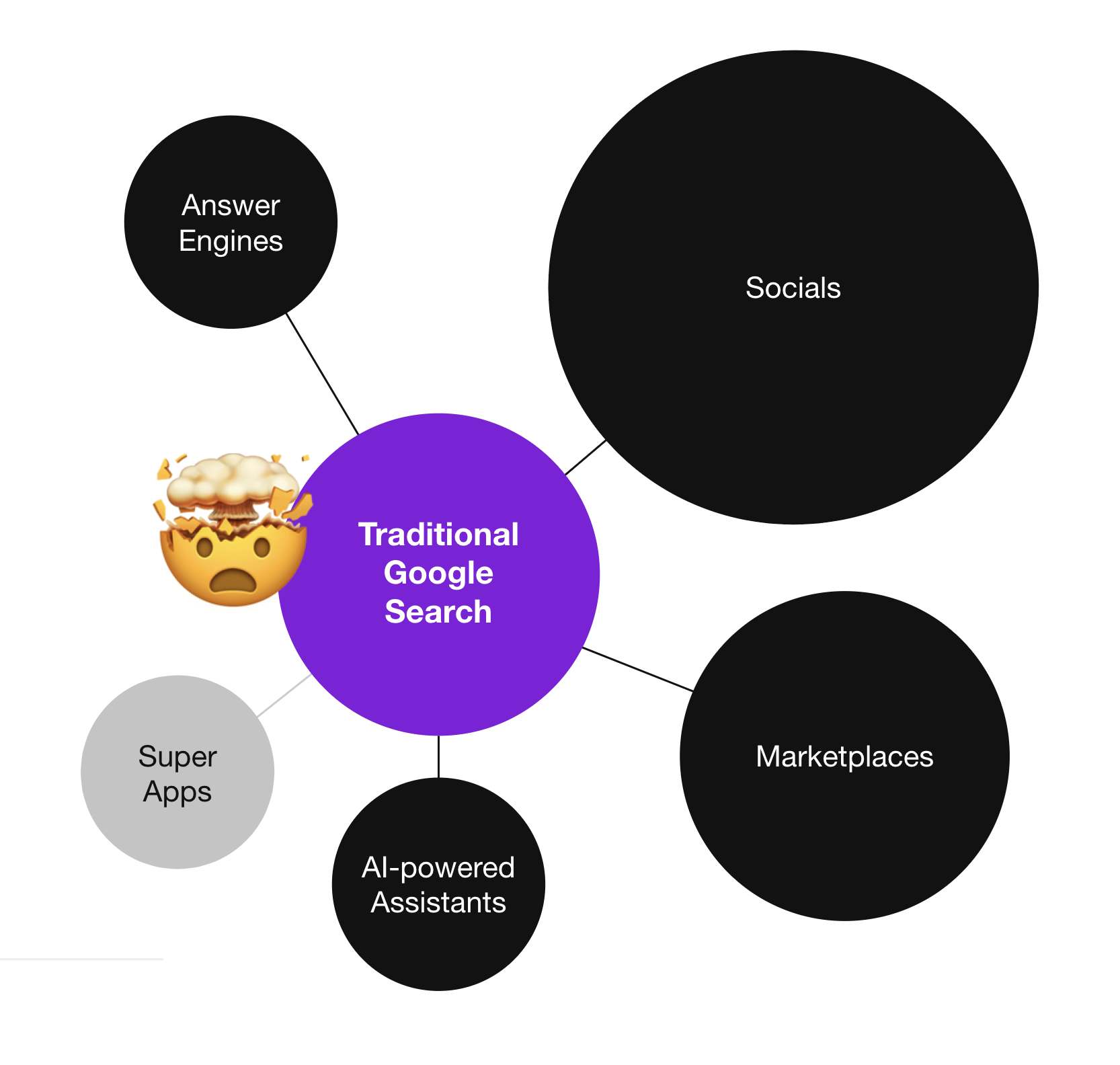How user search is evolving: here’s what it means for brands

Today, people spend only 9% of their screen time on the open web—www sites organised by Google search.
The bigger portion of their attention now goes to alternative ecosystems or islands—social media platforms and marketplaces where people search and discover information, opinions, and products.
The catch: these islands are designed to keep users tightly within their borders. With messaging, payment, and shopping functionalities in one place, there is less need for search engines.
For any brand that relies on being discovered via search, it’s time to act. In some cases, business models need to be completely reimagined to fit the new rules of the internet.

From search engines to answer engines
In just a few short months, generative AI has massively disrupted the internet experience. With the introduction of Google’s AI Overviews and Search GPT on the horizon, traditional searches are now powered by AI, providing users with more thorough, contextual results for queries right on the search engine results page (SERP).
With AI Overviews, users get answers and explanations to their searches, the opportunity to ask further questions, relevant shopping links, and more. Altogether, the AI-driven experience reduces the need for users to navigate off the SERP and click through to web pages, resulting in a rise in zero-click searches. Google does the googling for you.
As search results get smarter, the need to click on results decreases, and organic traffic becomes more difficult to capture.
Because AI Overviews take up a large portion of the SERP above the fold, advertising space for brands is getting tighter, driving search ad prices up. According to a Google Ads benchmark study from WordStream, the overall average cost-per-click has increased $0.44 year-over-year to $4.66, while the overall average conversion rate has decreased slightly from 7.04% in 2023 to 6.96% in 2024.
Search gets people-ised on social media
Social media platforms have disrupted the internet itself. Even search is moving here, especially for younger generations who turn to platforms like TikTok and Instagram as their main sources for search and discovery. 40% of Gen Z already prefer using social media over Google.
Social media search engines add “peoplisation” to the search experience, delivering users the products, news, and opinions the way they like it—from creators, influencers, and brands they like.
Individuals’ curated feeds allow search to morph into discovery as ever-learning algorithms do their magic. And with a constant flow of visual content, social media is an immersive and consuming experience, unlike any SERP or website.
Shopping also gets people-ised on social media. In many countries, people can buy and check out directly on Instagram or TikTok…with a click on a photo or video that shows an interesting product. Meaning: steadily decreasing traffic in traditional webshops.
Search and checkout meet on marketplaces
Marketplaces from Amazon to Temu to TikTok are increasingly becoming the starting point for product searches.
With a general product in mind, users can effectively compare specific products, brands, and prices, then check out all in one place. In the last year, 31% of product searches occurred on marketplaces, vs. just 14% on search engines. Nearly 60% of searches began on Amazon specifically.
The convenience of handling all shopping steps on one marketplace makes it a natural choice for shoppers. And it’s creating a self-enforcing loop: As marketplaces garner more shopping traffic, they draw more sellers, leading to shrinking prices and—of course—more shoppers. With massive investments in marketplaces, especially in Asia, and players with innovative business models, e.g. SHEIN, this shift will only accelerate.
AI assistants enter the chat
Meanwhile in the West, seven of the eight biggest companies in the world have entered the race to build the next mega platform: AI assistants.
Equipped with the ability to hear, speak, see, understand, and now do things, these assistants can handle much more complicated queries and tasks.
Planning and booking family holidays, scheduling doctor appointments, or running a research project are easy tasks you could think of. Assistants capable of this, like Open AI GPT4o, Google Astra, or likely the new Apple Siri, are all planned in the short term.
These companies bet that you will use AI assistants for the things you use the web for today. As you begin to lean on AI assistants, you’ll start to see fewer human eyes on screens, making digital ads less effective and digital marketing a whole new game. Follow-up questions and real dialogues will replace SERPs full of links —and continue to decrease traffic across the open web.
Everything converges on Superapps
Superapps are like “little internets” themselves, integrating social media, payments, communication, entertainment, shopping, food, travel, and more.
Platforms like WeChat, Alipay, and Meituan are making the open web obsolete in Asia. While this model hasn’t yet caught on in the West, you’ll likely see its emergence soon. Trend analysts from Gartner predict that 50% of people in the West will use super apps regularly by 2027, especially as techies like Mark Zuckerberg and Elon Musk have expressed aspirations to grow their respective apps into more integrated, “everything” platforms.
Implications for brands
With the evolution of online places, users are spending less and less time browsing the open web. So what can you do to ensure you aren’t left behind in this new era?
1. Crisp brand positioning
Showing up in third-party channels requires competing with hundreds of other brands. Even indie brands from the other side of the world can show up directly beside your product listing. On platforms with algorithmic curation, where popular content gets even more popular by design, it comes down to one thing: being a brand that people love to love.
This calls for a new level of sharply-positioned and well-communicated (sub-)brands created for increasing niche audiences. Another rising strategy will be brand-building through brand alliances, where brands (and influencers) cross-pollinate to grow their respective audiences.
2. Platform natives
Today, digital platforms like Instagram and Amazon are whole universes, with hundreds of advertising opportunities and complex targeting and measuring functionalities. These platforms also have their own culture, rules, tone, and tactics. Running elaborate platforms requires specialised talent and teams….platform natives!
By assembling specialised teams, you can develop hyper-targeted strategies. These teams can create content, campaigns, and experiences tailored to specific platforms, maximising reach, engagement, and conversion. Important prerequisite: these teams need their own resources and a certain freedom to move at speed to catch opportunities.
3. Channel alignment with the kitchen model
With deeply specialised teams, there are two problems. 1) The territorial competition for importance and budget between the channels, and 2) the resulting barriers to collaboration and sharing of learnings.
The mental model in which teams operate needs to change. Instead of hoarding resources, organisations need to switch to the kitchen brigade, the way professional chefs are organised. In this model, the different station chefs don’t compete for more of their ingredients but for a balanced dish.
In real digital teams, this could mean
1. Distribute channel budgets not according to the heritage or political power of a channel team but based on cold ROI calculations and the channel’s importance for the brand’s core audience.
2. Align the roles and goals of each channel within a user journey. Not all channels have to cater to all brand goals or user needs. Specialisation helps.
3. Plan campaigns and the evolvement of the platforms together, despite the deep specialisation of the channel teams.



